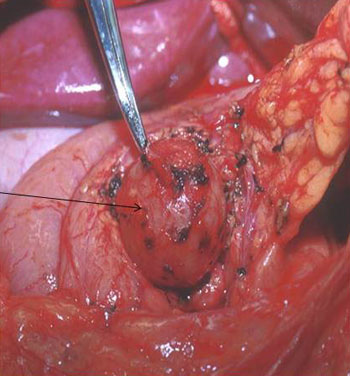High Levels of Vascular Endothelial Growth Factor Mark Noncancerous Pancreatic Cysts
By LabMedica International staff writers
Posted on 27 Feb 2014
A new noninvasive diagnostic test can differentiate benign pancreatic cysts from those that have the potential to progress to invasive pancreatic adenocarcinoma (pancreatic cancer).Posted on 27 Feb 2014
Serous cystic neoplasms (SCN) have no malignant potential, but can mimic mucinous pancreatic cysts, which have the potential to progress to invasive pancreatic adenocarcinoma, on imaging. The inability of medical imaging to readily differentiate between these two classes of cysts can result in patients having to go through extensive follow-up medical visits, invasive biopsies, and unnecessary surgery to determine the true nature of their pancreatic cyst.

Image: A benign pancreatic cyst is evident at the tip of the clamp in this photo (Photo courtesy of the Indiana University School of Medicine).
Investigators at the Indiana University School of Medicine (Indianapolis, USA) hypothesized that vascular endothelial growth factor (VEGF)-A levels in pancreatic fluid might correlate with pathologic diagnosis of the pancreatic cyst. They used an ELISA assay to determine VEGF-A levels in pancreatic cyst fluid taken from 87 patients with suspicious pancreatic growths including pseudocysts, SCN, mucinous cystic neoplasm, low/moderate grade intraductal papillary mucinous neoplasm, high-grade/invasive intraductal papillary mucinous neoplasm, and pancreatic ductal adenocarcinoma.
Analysis of the data revealed that VEGF-A was significantly upregulated in SCN cyst fluid compared with all other diagnoses, and that VEGF-A had 100% sensitivity and 97% specificity as an SCN biomarker.
Senior author Dr. C. Max Schmidt, professor of surgery, biochemistry, and molecular biology at the Indiana University School of Medicine, said, "This is the first cyst fluid protein biomarker that can differentiate serous cystic neoplasms, a benign type of cystic lesion, from all other cancerous or precancerous cystic lesions without surgery."
"Only 15% of pancreatic cancer patients will benefit from surgery, and of those, only about 20% will survive five years," said Dr. Schmidt. "Many of my patients when initially told they have pancreatic cysts are very fearful and ask for surgical removal of the cyst or the entire pancreas before they even learn their options. Now, physicians will have an outpatient procedure to offer that can take some of the guesswork out of the equation.”
The study was published in December 24, 2013, online edition of the Journal of the American College of Surgeons.
Related Links:
Indiana University School of Medicine














